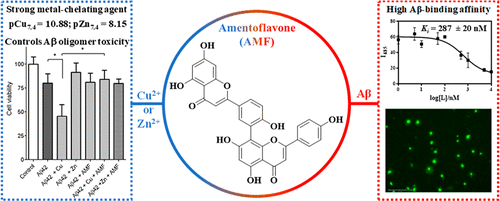当前位置:
X-MOL 学术
›
ACS Chem. Neurosci.
›
论文详情
Our official English website, www.x-mol.net, welcomes your
feedback! (Note: you will need to create a separate account there.)
Amentoflavone: A Bifunctional Metal Chelator that Controls the Formation of Neurotoxic Soluble Aβ42 Oligomers.
ACS Chemical Neuroscience ( IF 4.1 ) Pub Date : 2020-08-05 , DOI: 10.1021/acschemneuro.0c00376 Liang Sun 1 , Anuj K Sharma 2 , Byung-Hee Han 3 , Liviu M Mirica 1, 4
ACS Chemical Neuroscience ( IF 4.1 ) Pub Date : 2020-08-05 , DOI: 10.1021/acschemneuro.0c00376 Liang Sun 1 , Anuj K Sharma 2 , Byung-Hee Han 3 , Liviu M Mirica 1, 4
Affiliation

|
Alzheimer’s disease (AD) is the most common neurodegenerative disorder, yet the cause and progression of this disorder are not completely understood. While the main hallmark of AD is the deposition of amyloid plaques consisting of the β-amyloid (Aβ) peptide, transition metal ions are also known to play a significant role in disease pathology by expediting the formation of neurotoxic soluble β-amyloid (Aβ) oligomers, reactive oxygen species (ROS), and oxidative stress. Thus, bifunctional metal chelators that can control these deleterious properties are highly desirable. Herein, we show that amentoflavone (AMF), a natural biflavonoid compound, exhibits good metal-chelating properties, especially for chelating Cu2+ with very high affinity (pCu7.4 = 10.44). In addition, AMF binds to Aβ fibrils with a high affinity (Ki = 287 ± 20 nM), as revealed by a competition thioflavin T (ThT) assay, and specifically labels the amyloid plaques ex vivo in the brain sections of transgenic AD mice, as confirmed via immunostaining with an Aβ antibody. The effect of AMF on Aβ42 aggregation and disaggregation of Aβ42 fibrils was also investigated and revealed that AMF can control the formation of neurotoxic soluble Aβ42 oligomers, both in the absence and presence of metal ions, as confirmed via cell toxicity studies. Furthermore, an ascorbate consumption assay shows that AMF exhibits potent antioxidant properties and can chelate Cu2+ and significantly diminish the Cu2+-ascorbate redox cycling and reactive oxygen species (ROS) formation. Overall, these studies strongly suggest that AMF acts as a bifunctional chelator that can interact with various Aβ aggregates and reduce their neurotoxicity and can also bind Cu2+ and mediate its deleterious redox properties. Thus AMF has the potential to be a lead compound for further therapeutic agent development for AD.
中文翻译:

Amentoflavone:一种双功能金属螯合剂,可控制神经毒性可溶性Aβ42低聚物的形成。
阿尔茨海默氏病(AD)是最常见的神经退行性疾病,但尚未完全了解这种疾病的原因和进展。虽然AD的主要标志是由β-淀粉样蛋白(Aβ)肽组成的淀粉样蛋白斑的沉积,但众所周知,过渡金属离子还可以通过促进神经毒性可溶性β-淀粉样蛋白(Aβ)的形成在疾病病理学中发挥重要作用。低聚物,活性氧(ROS)和氧化应激。因此,非常需要能够控制这些有害性质的双功能金属螯合剂。本文中,我们证明了天然黄酮类化合物金黄酮(AMF)表现出良好的金属螯合性能,特别是对于以极高亲和力螯合Cu 2+(pCu 7.4= 10.44)。此外,正如竞争性硫黄素T(ThT)分析所揭示的,AMF以高亲和力(K i = 287±20 nM)与Aβ原纤维结合,并特异性标记转基因AD小鼠脑部的离体淀粉样斑如通过Aβ抗体免疫染色所证实的。还研究了AMF对Aβ42纤维的Aβ42聚集和解离的影响,并揭示了AMF可以控制神经毒性可溶性Aβ42寡聚体的形成,无论是否存在金属离子,这已通过细胞毒性研究得到证实。此外,抗坏血酸消耗量分析表明,AMF具有强大的抗氧化性能,并且可以螯合Cu 2+并显着减少了Cu 2 +-抗坏血酸的氧化还原循环和活性氧(ROS)的形成。总体而言,这些研究强烈提示AMF是一种双功能螯合剂,可以与各种Aβ聚集体相互作用并降低其神经毒性,还可以结合Cu 2+并介导其有害的氧化还原特性。因此,AMF有可能成为AD进一步治疗剂开发的先导化合物。
更新日期:2020-09-02
中文翻译:

Amentoflavone:一种双功能金属螯合剂,可控制神经毒性可溶性Aβ42低聚物的形成。
阿尔茨海默氏病(AD)是最常见的神经退行性疾病,但尚未完全了解这种疾病的原因和进展。虽然AD的主要标志是由β-淀粉样蛋白(Aβ)肽组成的淀粉样蛋白斑的沉积,但众所周知,过渡金属离子还可以通过促进神经毒性可溶性β-淀粉样蛋白(Aβ)的形成在疾病病理学中发挥重要作用。低聚物,活性氧(ROS)和氧化应激。因此,非常需要能够控制这些有害性质的双功能金属螯合剂。本文中,我们证明了天然黄酮类化合物金黄酮(AMF)表现出良好的金属螯合性能,特别是对于以极高亲和力螯合Cu 2+(pCu 7.4= 10.44)。此外,正如竞争性硫黄素T(ThT)分析所揭示的,AMF以高亲和力(K i = 287±20 nM)与Aβ原纤维结合,并特异性标记转基因AD小鼠脑部的离体淀粉样斑如通过Aβ抗体免疫染色所证实的。还研究了AMF对Aβ42纤维的Aβ42聚集和解离的影响,并揭示了AMF可以控制神经毒性可溶性Aβ42寡聚体的形成,无论是否存在金属离子,这已通过细胞毒性研究得到证实。此外,抗坏血酸消耗量分析表明,AMF具有强大的抗氧化性能,并且可以螯合Cu 2+并显着减少了Cu 2 +-抗坏血酸的氧化还原循环和活性氧(ROS)的形成。总体而言,这些研究强烈提示AMF是一种双功能螯合剂,可以与各种Aβ聚集体相互作用并降低其神经毒性,还可以结合Cu 2+并介导其有害的氧化还原特性。因此,AMF有可能成为AD进一步治疗剂开发的先导化合物。











































 京公网安备 11010802027423号
京公网安备 11010802027423号